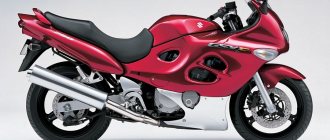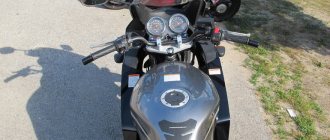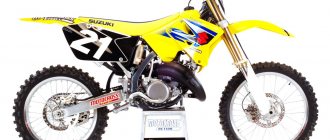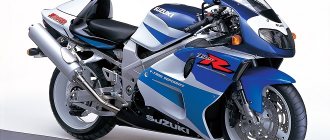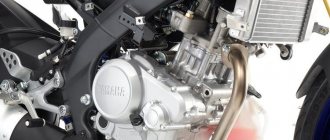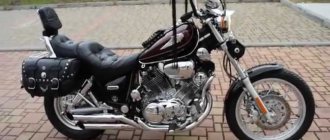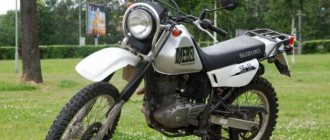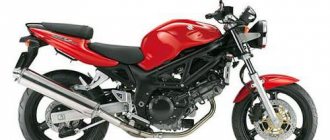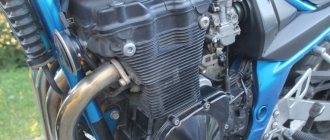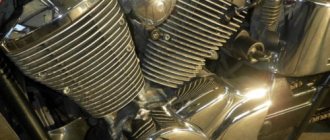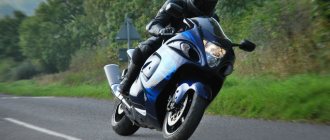Flaws
The Suzuki Katana 600 was built on a steel tubular-profile frame, equipped with an air-oil-cooled engine, a six-speed transmission and adjustable suspensions. The motorcycle had a significant curb weight exceeding 229 kg.
In the first years of production, the Suzuki Katana model was not entirely unambiguous; to put it simply, there were problems with carburetors and the materials used. However, gradually all the shortcomings were eliminated, and the assembly process improved.
The Suzuki Katana 600 GSX motorcycle was produced until 2006, then it was replaced by the more modern “650F” model. The new version became an intermediate version, preceding the Katana 750 F.
Description
The Suzuki GSX600F Katana sports tourer model appeared in 1988 as a budget universal motorcycle intended for sales in foreign markets - Europe and North America. The model was distinguished by a fairly simple layout and equipment, which had a positive effect on the final price and made the motorcycle one of the most affordable sports tourers in its class. The model was also sold under the name Suzuki Katana 600.
The model was based on a slightly modified engine from the sports Suzuki GSX-R 750, which was an in-line 4-cylinder air-oil cooling unit with a volume of 599 cm³, producing up to 86 hp. power and up to 59 Nm of torque. This engine was subsequently installed on the Suzuki GSF 600 Bandit road truck.
Since 1989, the model has received new suspensions, which have received additional adjustments, and since 1990, new larger carburetors.
In 1998, the model underwent a major restyling, seriously updating its appearance and technical parts. Currently, it is the second generation of the motorcycle that is popular on the market, since it has a more modern appearance and the usual wheel size.
Among the features of the Suzuki GSX600F Katana model, we should highlight a steel tubular frame, simple but adjustable suspension (the fork has rebound adjustment, the rear shock absorber has preload + rebound), 2-piston front disc brakes, a 6-speed gearbox, a 20-liter fuel tank and 208 kg of dry mass (for the second generation).
2006 was the last year of production, after which it finally left the market, giving way to its successor, the Suzuki GSX650F.
The “big brother” of the model is the Suzuki GSX 750F Katana.
Power point
- The engine is petrol, four-cylinder, in-line;
- cylinder volume, working - 599 cc/cm;
- compression - 11.3;
- cooling - radiator, air-oil;
- food - carburetor;
- ignition - contactless, transistor;
- power - 78 hp at a rotation speed of 10350 rpm;
- torque - 54 Nm at 7950 rpm.
Brief history of the model
1988 - start of production and sales. The first generation is GN72A. Model: Suzuki Katana 600 (Europe, North America). Factory designation: GSX600FJ.
1989 - The model receives a fork and rear shock absorber with rebound adjustment. Model: Suzuki Katana 600 (Europe, North America). Factory designation: GSX600FK.
1990 - the model receives larger carburetors - Mikuni BST33SS (instead of BST31SS). Model: Suzuki Katana 600 (Europe, North America). Factory designation: GSX600FL.
1991 - no significant changes. Model: Suzuki Katana 600 (Europe, North America). Factory designation: GSX600FM.
1992 - no significant changes. Model: Suzuki Katana 600 (Europe, North America). Factory designation: GSX600FN.
1993 - no significant changes. Model: Suzuki Katana 600 (Europe, North America). Factory designation: GSX600FP.
1994 - no significant changes. Model: Suzuki Katana 600 (Europe, North America). Factory designation: GSX600FR.
1995 - no significant changes. Model: Suzuki Katana 600 (Europe, North America). Factory designation: GSX600FS.
1996 - no significant changes. Model: Suzuki Katana 600 (Europe, North America). Factory designation: GSX600FT.
1997 - no significant changes. Model: Suzuki Katana 600 (Europe, North America). Factory designation: GSX600FV.
1998 - restyling of the model. Second generation - GN79A. The model receives a more modern appearance, a new rear shock absorber (with increased travel), new wheels (110/80 V17 → 120/70 ZR17 58W; 140/80 V17 → 150/70 ZR17 69W), new brakes (the rear disc has been reduced in size from 250 to 240 mm), new carburetors (Mikuni BSR32) and changes in the engine: power decreases 86 → 78 hp, torque 58.5 → 54 Nm. The battery capacity is reduced from 14 to 8 Amp*h. Model: Suzuki Katana 600 (Europe, North America). Factory designation: GSX600FW.
1999 - no significant changes. Model: Suzuki Katana 600 (Europe, North America). Factory designation: GSX600FX.
2000 - no significant changes. Model: Suzuki Katana 600 (Europe, North America). Factory designation: GSX600FY.
2001 - no significant changes. Model: Suzuki Katana 600 (Europe, North America). Factory designation: GSX600FK1.
2002 - no significant changes. Model: Suzuki Katana 600 (Europe, North America). Factory designation: GSX600FK2.
2003 - no significant changes. Model: Suzuki Katana 600 (Europe, North America). Factory designation: GSX600FK3.
2004 - no significant changes. Model: Suzuki Katana 600 (Europe, North America). Factory designation: GSX600FK4.
2005 - no significant changes. Model: Suzuki Katana 600 (Europe, North America). Factory designation: GSX600FK5.
2006 is the last year of production. Model: Suzuki Katana 600 (Europe, North America). Factory designation: GSX600FK6.
A little history
The end of the 70s of the last century was remembered for the absence of sports motorcycles on the market; at that time only road models were produced. Fast American cars were just beginning to be developed. Japanese engineers took the existing heavy two-wheeled motorcycle Suzuki GSX-1100 and based on it created the Suzuki GSX-1100F model. We minimized the weight of the vehicle and significantly increased maneuverability. However, the powerful heavy engine remained, and the “Katana” (as the new bike was called) became a motorcycle disproportionate in terms of power and actual weight.
Next, a line of Katana sports tourers was created, which began to be produced as the Suzuki Katana GSX 600, with an engine of 599 cubic meters of displacement.
Until the early 90s, Katana motorcycles looked like regular road bikes, with a high-mounted fuel tank and a straight seat. But soon changes occurred in the appearance of the bike: at first the engine was completely covered with fairings, the seat smoothly merged into the rear wing and was sharply raised up at a large angle. Thus, the long-awaited sports and racing lines appeared in the guise of the Suzuki Katana.
Review of the Suzuki GSX600F Katana motorcycle
Previously, like many others, I traveled on Soviet vehicles Minsk, ZiD, Ural and cherished the dream that one day I would ride my Japanese one. I’m a sociable person, and when I was in the city riding my Ural I managed to meet someone and ride some motorcycles. And of course, like the majority of people, I didn’t breathe evenly at the sight of sportbikes, their graceful lines, the temper in their gaze, the roar from which my soul sank to my heels when such devices passed me. Well, one day the stars in the sky were in the right phase and my financial situation allowed me to think about buying my first Japanese car, it was approaching autumn, I wanted anything to start with with a volume of at least 400 cc, but after finding out through old acquaintances the option GSX600 F turned up, it was in the showroom without mileage in Russia, the price was 140 thousand, but since it was already the end of the season they gave a discount of 30 thousand. And so this story began. The preface is a bit long, but some people find them interesting. The engine of this motorcycle produces 80 horses, but very calm ones, acceleration is smooth and reaches its peak power at about 9500 thousand, after 10 there is no point in turning, the maximum speed is around 220, but after 190 the motorcycle accelerates very reluctantly. Comfortable speed on the highway is 140-150, but the highway is his element. In corners, the 220-kilogram “Katya” behaves with dignity and predictability, even with a passenger you can give a decent angle, of course, a lot depends on the tires, the suspension, in principle, is not bad for a sports tourist in coping with unevenness. a huge 20-liter tank gives the motorcycle a truly serious power reserve - almost 400 km, and the light on this motorcycle is simply a fairy tale, with a distance really like daylight, I have never seen such good optics on any motorcycle. The motorcycle is very balanced and I would recommend it to beginners who have the basics of driving a motorcycle because their ambitions do not allow themselves to ride anything smaller than 600cc. The downside of the motorcycle is the brakes; only after riding it properly do you begin to understand when the front wheel locks; you often have to help with the rear, which separately from the front does not give any effect. It’s not suitable for shots around the city due to the power-to-weight ratio; for my leisurely walks in the countryside it was suitable; it can be used as a long-range shot, but my shoulders hurt from a long drive. Air - minimum maintenance. I sold the motorcycle with tears in my eyes to the guys who wanted to stunt. But ahead of me was the purchase of a Honda X4, which, compared to a katana, is just a cannon. And the katana is a wonderful budget 600 that will carry your happy ass for many, many kilometers. Thank you for your attention and good luck on the roads, friends!
Object: Suzuki GSX 600 F (Katana) 1999. Class: sport-tourist.
This is my first and so far only motorcycle. Therefore, the assessment may be a little one-sided, although I took other models for a ride from my friends... But it didn’t last long. So:
I weighed, tried on, walked and thought for a long time. I realized that 600 is the minimum, and to begin with, the optimum. I was struck by the beauty of this device, and most importantly, my wife was struck at the same time, which was only beneficial in the future!!! The driving performance is good, I have driven almost 40 thousand km on it in 2 seasons. I went to work every day, and, accordingly, on long-distance vacations (with a samovar, of course!). It didn’t show any problems during this time, even though I didn’t buy it new, but with 25 thousand km. mileage There were no problems with consumables, but with serious spare parts. In some parts the problem is present. I realized this after the fall. :(( It was easier to replace the engine completely than to restore it with a bent crankshaft!!! I found the engine by chance in Moscow, which I was incredibly happy about - lucky!!!!
Summary - a cool device. Reliable, handsome (there are very few of these in Moscow), good-natured. Those. all positive – that’s why we buy “iron horses”!
I purchased it last year and have some observations.
For me (I weigh 60 kg) it’s a little heavy, but I’ve gotten used to it little by little, although in the city it’s a little clumsy. Outside the city, the beauty moves only in very strong winds. I noticed that after 160 km it begins to bounce slightly, this is annoying and interferes with the enjoyment... until I figured out this problem... Also, you should never let go of the steering wheel on it, the sausage is wild, you can even somersault. Maybe it’s the same for me, but a friend bought a classic Honda and the same thing happened there...
The expense didn't make me think about it.
Brakes: the front ones are a little weak, I would like them to be sharper. There are no complaints about the rear ones. Light: My vision in the twilight was terrible on my work machine, but here everything is fine. Gearbox….I didn’t even think about it, it’s probably my left leg that’s thinking, but very quickly I added 200 grams of oil during the season
. Separately, I want to tell you about the step (side).. I had a terrible time with it. It didn’t stand securely anywhere, no matter how you placed it. Just push it from behind and it would fall. Because of this, it was dangerous to leave it in the yard, in case the children wanted to touch it and climb, and it was damned from the wind and would fall over. More or less, I only stood with my face uphill. And on the border with Russia there was a joke: there, if you go down from Ivangorod towards Narva, there was a queue downhill and I had to stand in line backwards like a crayfish. Now it’s funny, then my nerves were burning. In general, I solved the problem with a grinder, trimmed the footrest's support point and thereby increased its forward reach. Now the moto stands on any surface.
I ride around and think: either it has lost power in 2 years, or I already want something more frisky.
This is my first moto, my friends said that it wasn’t quite suitable as the first one, they say it was heavy and clumsy, but I learned carefully and am still learning. But here I sat down on a classic from a friend and was amazed how easy it was, like on a moped.
Good for good roads, I drove it to the Leningrad region: the plastic rattles, you can’t go fast, the potholes are boring, trucks are overtaken, in general it’s a pity for it on such roads.
I use it as a stroller or for traveling on the highway with non-extreme trips for overnight stays and picnics.
Facing
A lot of work has been done with the plastic body kits. Their location determined how the motorcycle would look from a design point of view.
The entire front part of the plastic cladding was made in the form of a complex technological profile, which housed dual headlights, turn signals and a windshield. The lower part of the body kit covered the top of the engine and continued to the seat. The gas tank remained uncovered.
Body kit number two completely covered the entire lower part of the engine and partially the rear fork. And finally, a third plastic body kit masked the frame and exhaust pipe.
Suzuki gsx 750 f Katana, technical specifications
The improved model GSX Katana 750 F was presented in 1988 and was produced until 2004. The motorcycle was equipped with an in-line four-cylinder oil-cooled engine, derated and tuned for optimal traction at medium and low speeds.
The first generation of the Katana 750F model was produced from 1988 to 1997, with a 106 hp engine. The design of the motorcycle was already outdated and required deep restyling.
The second generation Katana 750F has radically changed its appearance and acquired a more modern design. The engine reduced power slightly and was already producing 93 hp. at sixty-six newtonometers of torque.
In Russia, the second generation motorcycle became the most popular, since the appearance of the bike gave the impression of an ultra-modern motorcycle. In addition, engine performance has been significantly improved.
The Katana 750F model received a new steel frame of a drawn tubular profile, especially durable, but quite elastic. Effective suspensions with simple adjustments were installed, which gave the motorcycle additional shock-absorbing properties.
The rear suspension monoshock absorber was adjustable over a fairly wide range, and the front suspension leaves with a diameter of 45 mm had a stabilizing effect on small uneven road surfaces, so that the car moved smoothly and at a good speed. The technical characteristics of the Katana 750 F are almost identical to those of the Katana 600; the motorcycles differ only in the volume of the fuel tank (20.5 liters for the Katana 750 F versus 20 liters for the Katana 600).
Some distinctive parameters of the Katana 750 F model:
- dry weight - 211 kg;
- curb weight - 227 kg;
- maximum speed - 230 km/h;
- height along the saddle line - 805 mm;
- rear suspension monoshock travel - 142 mm;
- front suspension fork travel to damper rebound - 130 mm;
- front tire sizes - 120/80 ZR 17;
- rear tire dimensions - 150/70 ZR 17;
- front brakes - two paired discs, ventilated, with a diameter of 290 mm;
- rear brakes - single ventilated disc, diameter 240 mm.
Otherwise, the Katana 600 and Katana 750 models are identical.
Driving performance
The maximum speed indicated in the documentation is 210 km/h . The owners say that it is possible to dial it up, the acceleration is confident, but the motorcycle gains speed above 190 km/h extremely reluctantly.
Dynamic performance (acceleration and cruise)
- Comfortable cruiser - 130-150 km/h .
- Acceleration from zero to 100 km in 4.2 seconds .
According to users, these are excellent indicators for a tourist.
Fuel consumption
Consumption, according to the manufacturer’s documentation, is 5.4 liters per 100 km . Users note:
- on the highway 5 l ,
- in the city 7-8 l .
It all depends on your driving style. Provided that the tank is as much as 20 liters , the average distance at one gas station is quite impressive - around 400 km .

